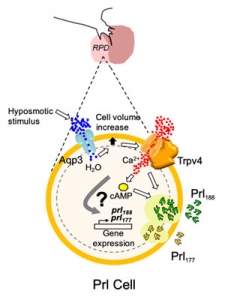
Fish that live in both seawater and freshwater must adjust to changes in salinity in order to survive. But how do they recognize the salt concentration in their immediate environment?
A new multinational study, led by Assistant Research Professor Andre Seale of the University of Hawaiʻi at Mānoa College of Tropical Agriculture and Human Resources Department of Human Nutrition, Food and Animal Sciences, is expanding knowledge of how specialized cells can sense the environment, respond to environmental change and regulate the internal environment.

The research is based on the notion that growth and environmental adaptation are regulated through the orderly release of hormones by the neuroendocrine system, which integrates information from genes and the environment.
“We knew from previous work using Mozambique tilapia, a fish widely used in aquaculture, that the hormone prolactin is responsible for maintaining salt-and-water balance,” said Seale. “So we used bioinformatics to identify the genes that are both sensitive to environmental salinity and regulate the expression of prolactin.”
The next step is to identify DNA targets in the gene that respond to salinity challenges, and from there, develop biomarkers to identify salinity stress and adaptation in aquaculture and wild fish, including how salinity may affect their health and growth.
“Other vertebrate genomes could be searched for conserved DNA sequences, which might potentially unveil new targets that, in turn, would shed light on how the body responds to changes in salt concentration and potentially unveil novel markers for salinity stress,” Seale added.
The study, “Transcriptional regulation of prolactin in a euryhaline teleost: Characterisation of gene promoters through in silico and transcriptome analyses,” appears in the latest Journal of Neuroendocrinology.

